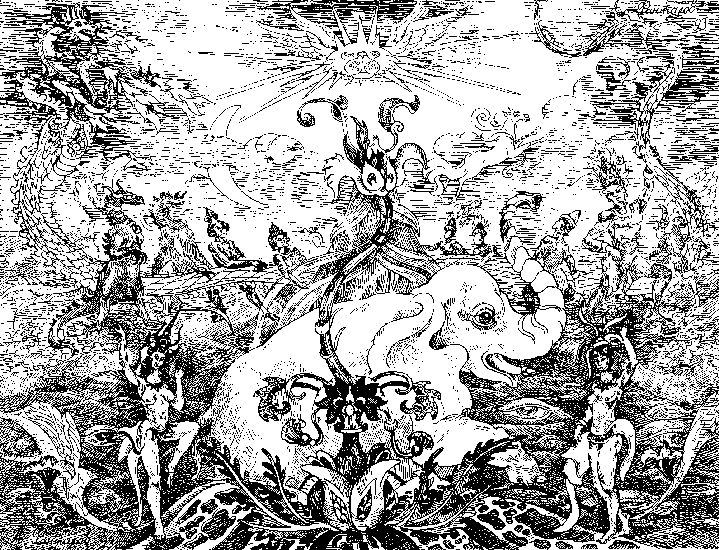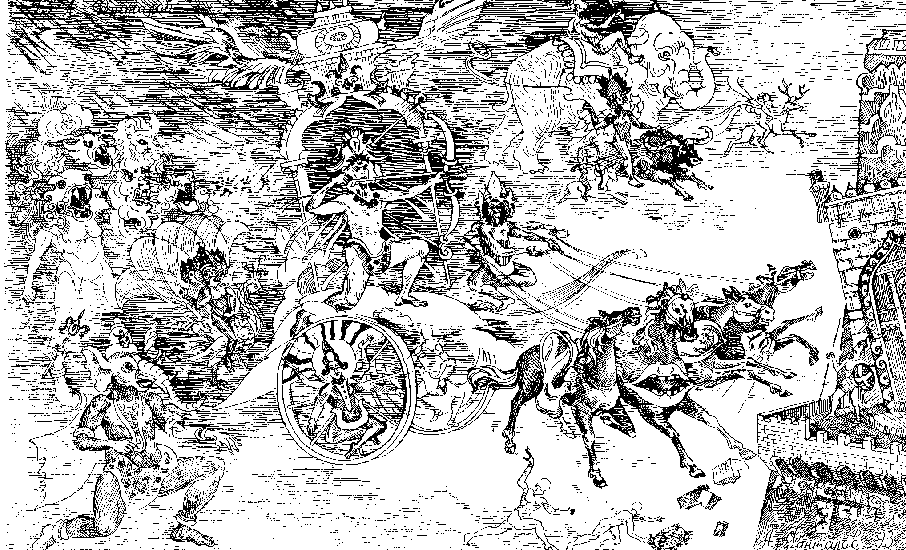|
|
|
Hindu myths 4.
Two type of Indo-European gods: the Cultural Hero and the God of Earth Powers are more complicated problems. The God of Earth Powers was correlated with ground as area of growth and dying, circulation of life and dead. He was diverged into many lines of development. On the one hand we can see the gods, who names descended to pro-Indo-European -uel-, connected with world of death (Slav Veles, Balt Veles, Indian Vala , Etruscan Veltha ). I think this is a main trunk of development of type. On the second hand there are local god personified an element of forests (Greek Pan, Indian Pushan, Balt Puskait). Many gods who should be belonging to type of the God of earth powers have got special names. I suggest that this variety connected with tendency to use not main (sacral) names but ephitets. Besides, some features of this god have begun to seem not appropriate and turned into independent images (for example: beside Indian god Rudra we see demon Vala ).
The possessor of natural power Rudra was The God of Earth Powers. One of Rudra's ephithets is Pasupati, "the master of cattle". Possibly, this character originated from representations on the sighns of Indus civilisation. The divinity supported with animals on this sign and resembls Celtic Cernunnos. Then Rudra became one of the great medieval god Shiva's names.
I suppose that the priests stand up for the God of Earth Powers. Just this personage was connected with magy (Celt Cernunnos, Scandinavian Freyr, Balt Vels). Dahghda - resent embodiment of Cernunnos was named 'the god of druids'. Indian Varuna, Balt Vels, Slav Veles were the protectors of singers. Lastly if we will agree with Dumezil that Varuna corresponds Ahuramazda , it should be to say that first monotheistic religion was created by Zaratustra in terms of character who descend to the God of Earth Power's type.
As one of functions the God of Earth Powers was protection for animal kingship, he has got zoomorphic symbols. His sacral animal (and perhaps embodiment) was a bull. Therefore Rudra, Dyonisos, Veles have got horns. The horns are features sexual and warrior power. In ancient times these attributes were considered as good symbols, but Christians rejected them (probably as feature the main pagan divinity). However during the Middle Ages the horns were liked with some groups connected with heritage of European barbarians. I mean ritters who decorated with the horns their helmet and insignias. So the feature of the priest's divinity became warrior symbol.
Sometimes the God of Earth Powers identified with a stag or a ram (although these symbols of the Cultural Hero but these types were not always delimited).
The mythology of the God of Earth Powers includes some plots what could be form successive chain: the marriage with the Great goddess that embodied an alliance of two origins of fertility; the conflict with the God of Thunder (the subject of stealing of sacral cows in Balt, Slav , Indian , Greek mythologies); the torment of the God of earth Powers.
The origin of the Cultural Hero's type is a primary ancestor of peoples. Indo-European peoples have got two tendencies of this type development: first one embodied 'cultural' aspect of character, second one showed heroic aspect. First tendency created image of king of legendary Golden Age, demiurg and protector of people (Persian Yima); than - first dead and the king of ancestors (Indian Yama); than psichopomp and mediator (Balt Sovius, Greek Hermes , Roman Mercury, Scandinavian Odin, Celt Lugh).
As for socium, that Hero as legislative, physician and protector become an embodiment of sacral king power. Roman emperors were pictured with attributes of Hercules. Many Greek dynasties believed that Heracles was their ancestor. Like picture we see in Scandinavian countries for Odin.
The character of hero-rider had got a great future. Christian Europe identified him with Saint George - the rider on white horse, the winner over dragon. The appearance of Hero is connected with eschatology, messian ideas. The character of Hero have penetrated into Buddhism, mitraism. Important significance it has got for Hinduism. Tenth avatar of Visine is a horseman with a flaming sword. This is Kalki who will appear at the final of world to punish of evil. It is not accidentally, that Hegel has imagined 'the finish of history' at the moment when he has seen Napoleon on the white horse.
A. Fantalov

Whipping of Dairy Ocean. (A. Fantalov, the image in Indian ink).
Hindu myth talks as once upon a time gods and demons-asuras have wanted eternal life. By advice Vishnu they have decided to whip Dairy Ocean to be going Amrita, a drink of immortality. Instead of a cord king of snakes - Vasuki, and by means mountain Mandara was taken served. King of turtles (it was Vishnu) held it at the bottom of ocean. Asuras have taken great the snake for a head, gods for a tail and hundreds years were whipping down Ocean.
From waters have appeared:
Asuras tried to take hold of a bowl with Amrita, but, due to Vishnu brain, the gods have got it. So, according to Hindu myth, demons have lost hope for immortality. Asuras in anger have overtaken gods, and there was a most severe fight. Gods have banished them under the ground and on a bottom of ocean.

"The Great God Shiva" (A. Fantalov, the image in Indian ink).
The drawing shows wellknown Hindu myth. The great Indian god Shiva is destroying Tripura - the magic fortress of asuras. We can see the army of gods. The horses of chariot personify Vedas. The Brahma is driving chariot. A god with an elephant head is Ganesa (a son of Shiva). Other gods is riding on the various animals.
Slavic myths 1. Menu